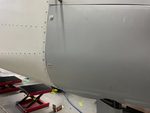Press fit forces of cozycarb - revisited
Revisit of calculations done previously

Youngs modulii of both the cozycarb and bing carb both assumed to be annealed pure aluminium Ei, Eo = 69x10^9 Nm^-2
Poisson's ratio of both the cozycarb and bing carb both assumed to be annealed pure aluminium vi, vo = 0.35
d = 0.0432m (43.2mm)
do = 0.058m (58.0mm)
di = 0.036m (36.0mm)
w = 0.010m (10mm) allowing for the presence of the slot
delta (difference of radii) = 0.000065m (0.065mm)
Assume friction us = 0.42 (static friction)
Computed P = 11.49*10^6 Nm^-2 (MPa)
This pressure is about half that previously computed, the previous calculation misinterpreted delta as being the diameter difference rather than the radius difference. The present calculation is correct.
This pressure is well below the yield strength of aluminium ~ 95 MPa suggesting that the stresses throughout are well below this number so the deformation is purely elastic. Perhaps it is true that any deformation in the Bing carb outlet flange and body - once the cozycarb is fitted - are also elastic.
A = 0.00136 m^2
Therefore F = 0.42*0.00136 *11.49*10^6 = 7.79*10^3 N = 667 kgf
About 670 kg press-fit force required
I am also using a friction coefficient of 0.42 rather than 1 used previously, and a depth of 10mm rather than 15mm. Both of these will further reduce the press-fit force compared to that used previously
Use of loctite will reduce the friction coefficient and the press-fit. If the friction coefficient is reduced to 0.2 (this is a guess) the press-fit force becomes even lower at 317kgf
Again, the previous calculation did not take into account the lubricating effect of the loctite
The fact that the deformation remains elastic suggests that the manner of the press-fit is less important than the final configuration, i.e that a thermal fit might also be feasible where the expansion of a heated cozycarb is sufficient that it is just slipped over the bing carb outlet
Aluminium coefficient of expansion 23^10-6 per degree C
For no interference an expansion of the Cozycarb by 43.22/43.09 - 1 = 0.003 is required. Use of a preheat temperature above ambient of 0.003/23X10^-6 = 130 degrees Celsius will reduce the interference to zero
If the cozycarb is pre-heated to 150 degrees Celsius then the press fit forces could be reduced to zero. If heated to 90 degrees Celsius the press-fit forces could be greatly reduced. The challenge in doing this is to do it quickly enough that the Bing carb outlet is not also heated too much that is also expands. The main part of Bing carb outlet must also be coated in the sealant. This should be done first so that the thermally-assisted press-fit can proceed as swiftly as possible. One idea is to do the first stage of press-fit heated ensuring alignment, then complete the remainder of the press-fit at ambient temperature.
Heating the cozycarb to (say) 90 degrees the press-fit forces will be reduced to just 158kgf, assuming the use of the loctite with 0.2 friction coefficient.
This post is from Adam Dickson
